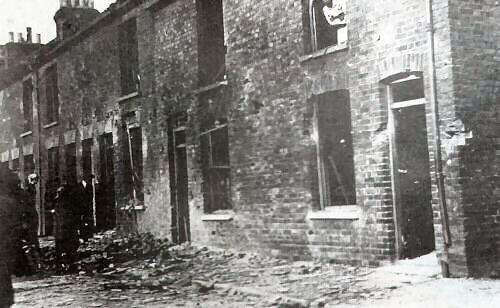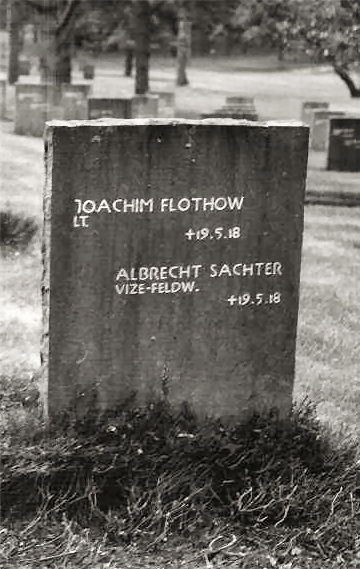
1686x1038 402KB
Zeppelin's Over Milton
The Title of this section is taken from a painting that hung in my Father-in-Laws pub "The Ypres Tavern" for many years.
Air Raids During the War
The area around Sittingbourne suffered constant air raids by Zeppelin's and aeroplanes during the war.
Indeed, they extended from Christmas Day 1914 and ceased on Whit Sunday 1918. A total of three and a half years.
The Germans used the town to get their bearings on their way to bomb London.
The first visit by a German aeroplane happened on Christmas Day 1914.It was a clear and sunny day and the German
airman flew up the Thames and Medway estuary. He dropped one bomb before making his escape. Guns at Sheerness fired
at him and one shell dropped into a field at Iwade. All was quiet then, until April the 16th 1915 when another
solitary flyer from a German Aerodrome in Belgium paid the people of Sittingbourne another visit.
This aircraft was a Taube and its wings glistening in the sunshine of that bright spring day, attracted unwelcomed
attention. The German was pursued by two of our own airmen, but he had the superior aircraft and out ran our chaps.
He circled Gore Court Park (now King Georges playing field), camp of the Royal Dublin Fusiliers and dropped two or
three bombs. One fell in Fulston orchard where the only casualty was a Blackbird, much to the amusement of local folk.
During the latter part of May 1915, tales of monster Airships attacking the coast of England could be heard in shops
and pubs around the town. Raids on Southend, Ramsgate and the East End of London were followed by one on Sittingbourne.
Some wag had suggested it was revenge for the fun the town had had over the death of the Blackbird, but it was really
a case of mistaken identity. The Airship had in fact been looking for the Gunpowder works in Faversham.
It was 11:30pm on the night of 4th June 1915. The still and silent night, heavy with the scent of summer flowers, was
shattered with the noise of a massive explosion. The people of the town, who moments earlier had been in bed or were
about to be, realised a Zeppelin was upon them. The airship was first sighted over Murston, heading towards the town.
It dropped a couple of dozen incendiary bombs and four high explosive bombs, before unloading more bombs at Rainham
and further up the river at Gravesend. Twenty eight incendiary bombs were harmlessly recovered. The four places the
high explosive bombs fell were: Unity street, an orchard between Charlotte street and Chalkwell rd (now Watsons hill)
another at St Pauls Street near Pear Tree Alley and a fourth in the middle of a wheat field at Chilton farm. This
last bomb was the only one to fall in the parish of Sittingbourne. The other three fell within the parish of Milton.
Above can be seen the damage in Unity street by the Zeppelin's bomb, which hit the back garden wall of a house in Park road, occupied by a Mr H W Harvey. Although many people were in the vicinity that night, indeed one woman had a lucky escape when a piece of shrapnel buried itself in the wall above her bed, all escaped serious injury.
About one hundred air raid warnings were received at Sittingbourne during World War One. Local
Anti-Aircraft batteries were strengthened in 1917. One known locally as "Screaming Lizzy" was situated
at Lower Halstow and was "a terror to the Huns".
The last big raid to pass over the town on Whit Sunday 1918 (19/05/18) by several German Gotha's, produced the
most terrific barrage from the ground defences the town had ever seen. Two of the German bombers were brought
down in the area. One fell in flames at Harty, killing its three crew members, the other came down at Frinsted.
Two of its crew also perished, but one survived with only a broken arm (this fact was not reported at the time?). The local news paper
reported : "The first of these duels occurred about an hour after the raid had been in progress,and probably
this machine was caught while on its way to London. It was engaged by a daring aviation officer while at a great height.
The British airman attacked his opponent so fiercly that the German was forced down to a lower height, and ultimately,
to the joy of the onlookers, the Gotha burst into flames, seemed to break in two and came down piecemeal, all aflame.The wrecked machine and the three occupants fell by a farm. Two of the Germans fell into marshy ground and their bodies
deeply embedded in the mud. The third man's head struck a wall and was shattered like an egg shell. All three bodies were
removed to a local aviation establishment. The fall of the burning Gotha was seen for miles around".
The second Gotha was surrounded by British fighters later the same day. It had
been on a successful raid in London and was attacked whilst trying to return to
its base across the channel. One fighter attacked the Gotha from below,
wounding both pilot and observer, but it managed to shake of its pursuers.
Later the same aircraft was looking for a Flarepath at Frinstead so that it
could land safely. However this was unknown to the British Fighter that spotted
it over Throwley and it was attacked again, it plunged to the ground between
Frinsted and Harrietsham just after 00.45.

"FST" on the fuselage, standing for Flothow/Sachtler/Tasche
The following Wednesday the Military funerals of the dead German aviators took place in two local Cemeteries:
Harty and Frinstead. British pilots who were involved in the action over the fields of Kent were in attendance
and the German airmen were buried with full military honours. Losses at this time were so great for the German war machine that they soon stopped their raids altogether.

Cannock Chase German Cemetery
I have since discovered the identity of the German pilot buried at Frinstead. He was Albrecht Sachtler, born in
Alexisbad, Saxony-Anhalt Germany in 1896. The observer, who was in charge of the
aircraft was Lieutenant Joachim Flothow who also died. The rear gunner was
gunner Uffz Hermann Tasche who survived and was taken prisoner.
During the early 1960's I believe the bodies of all five aviators were moved to the German War Cemetery at Cannock
Chase, Staffordshire.
Another account is given in The Sky On Fire: The First Battle of
Britain, Major Raymond H. Fredette, USAF, pages 208-209:
On Whit-Sunday evening, 19 May, an aircraft was heard circling off the North
Fore]and on the Kent coast. British observers were puzzled as it hovered in the
moonlit sky without flying inland. The mysterious machine left a flare burning
brightly over the sea, and its drone faded away. The lull was brief, for German
bombers were already winging their way towards England. The flickering light was
a signal telling them that the weather to the west was clear.The first warning
reached London at 10:42 P.M. From that hour, German aircraft kept coming in at
Ave-minute intervals until long past midnight. Hundreds of observer reports
jammed the telephone lines at the defense sub-commands and the Horse Guards. An
ominous roar filled the warm night air throughout Kent and Essex. The bombers’
courses crossed and recrossed as some passed out to sea, and still more came
in.Unlike other nights, when the raids had been made by only a few elusive
Giants, British airmen found the ,,,,,skies swarming with Germans. Captain
Brand, one of the pilots who had made the first night flight in a Sopwith Camel
with Murlis-Green, came across one incoming Gotha. He was patrolling out of
Throwley aerodrome when he was attracted by searchlights, probing between
Canterbury and Faversham.‘I arrived over this vicinity still climbing...’ Brand
wrote in his report. ‘I turned to engage the enemy aircraft.... His rear gunner
opened fire. I immediately returned his fire, and a subsequent burst apparently
put his starboard engine out of order.‘The aircraft did a rapid turn with nose
well down, and passed beneath me. He was going downwards rapidly. Soon after my
opening fire the aircraft burst into flames, which also enveloped my own machine
for an instant. The aircraft fell to earth in pieces over the south-east side of
the Isle of Sheppey.’223
Another Gotha flew a ‘perfect course’ up the Thames to London, eluding the
Sheerness defenses and some searchlights at Tilbury. After unloading on
Rotherhithe and Peckham, the raider was set upon by Major F. Sowrey, the
commander of 143 Squadron. He fired two drums of tracers before his guns jammed.
The bomber flew on, but with the pilot wounded. A Bristol Fighter from 141
Squadron later attacked the same Gotha. Blazing away at close quarters, the two
crews engaged each other in furious combat. The German pilot side slipped
sharply, seeking to upset the fighter with his slipstream. He again managed to
break away, this time with a shot-up engine.The limping Gotha had nearly reached
the coast when it turned back. Flying low over the aerodrome at Harrietsham, the
Germans fired distress signals. They attempted to land and crashed. Only the
rear-gunner survived. Nursing a broken arm, the sergeant told his captors that a
large fire was raging in London.The prisoner also settled the counterclaims for
the victory. He confirmed that it was the ‘Brisfit’ which had made the fatal
attack. Lieutenant Edward E. Turner was given one of the Gotha’s machine-guns,
and his observer, Lieutenant Henry B. Barwise, a propeller. Both airmen received
the D.F.C. and a black cross from the downed bomber was tacked up in the
squadron mess. The ‘kill’ was the first for Biggin Hill aerodrome. The squadrons
stationed there during World War II destroyed some 1,400 German aircraft, a
record unequalled by any other fighter station.
223 Ashmore, Edward B., Air Defense, (London: Longmans, Green, 1929), page
87